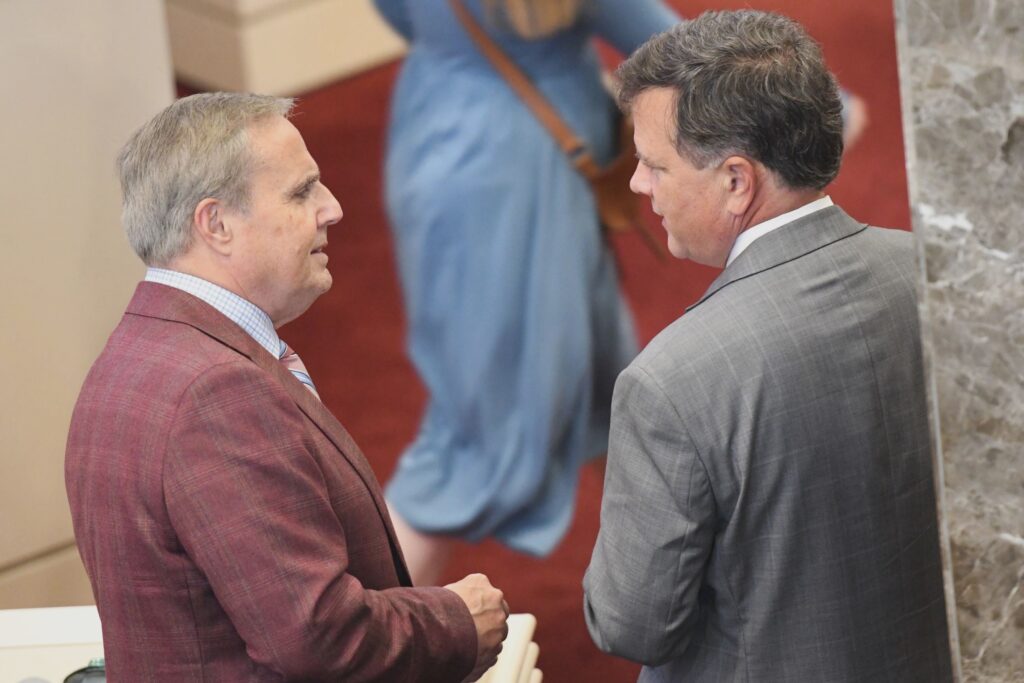
Rep. Danny Garrett, R-Trussville (left), the chair of the House Ways and Means Education Committee, speaks with Sen. Arthur Orr, R-Decatur, the chair of the Alabama Senate Finance and Taxation Committee, in the Alabama House of Representatives on May 8, 2024 at the Alabama Statehouse in Montgomery, Alabama. (Brian Lyman/Alabama Reflector)
State lawmakers Tuesday looked at different ways to make a major change in Alabama’s decades-old public education funding formula.
The three student-weighted funding models, aimed at better matching resources to the varying needs of students, would cost between $112 million and $200 million a year. Each would do away with the current hybrid-foundation model, tied more to average daily attendance at a school.
Sen. Arthur Orr, R-Decatur, the chair of the Senate Finance and Taxation Education Committee, said the Legislative Study Commission on Modernizing K-12 School Education Funding is “not beholden to any” of the three models presented, calling the models a “starting point for discussion.”
“We’re going to learn more about what’s possible as we look at these models, and then we need you all to help us think through the decision-making process,” Orr said to participants as he started the meeting.
GET THE MORNING HEADLINES.
Under Alabama’s existing funding framework, only 1.2% of state education funds specifically address student needs, such as those for students with disabilities, English language learners and students in poverty.
Rep. Danny Garrett, R-Trussville, the chair of the House Ways and Means Education Committee, said that he wants to better fund student needs, with a goal of increasing funding for districts and giving them more flexibility in how they spend their state allotments.
“We want all systems to see an increase, [and] no one to take a decrease,” Garrett said.
The proposed models — Model 1, Model 2 and Model 3 — differ in funding growth assumptions, but each would provide districts with baseline funding and additional “weights” for students with specific needs. Model 1 would cost $112 million. Models 2 and 3, which provide more funding to students and more weight to different needs, would cost $150 million and $200 million. In Model 3, high-poverty districts could see funding increases as high as $2,000 per student.
Jennifer Schiess, senior partner and practice lead for policy and evaluation at Bellwether, an education nonprofit, told the commission Tuesday that lawmakers would have to decide which specific needs would be weighted and how much that weight would be. Schiess provided models that weighted for low income students; students in special education; English learners; gifted students and those who attend charter schools, which is meant to supplement funds charter schools don’t receive from local government.
Schiess said that each model provided can be adjusted, and lawmakers can decide how to “mix and match these all different ways.”
“[Weight] is kind of determining how much goes in the base. Again, that’s kind of that first decision, and then which weights and how much are the second set of decisions, along with what are the eligibility criteria for those weights, which is another important set of decisions,” Schiess said.
Kirk Fulford, deputy director of the Legislative Services Agency, told the commission that despite a possible second reduction of 1% to the state’s sales tax on grocery items in the future, the Education Trust Fund should remain stable.
“I think my purpose here today is to try to tell you that whatever you decide to do, you can afford to do it,” Fulford said.
Sen. Greg Albritton, R-Atmore, chair of the Senate Finance and Taxation General Fund committee, seemed optimistic about the state’s financial ability to change the education funding formula. Fulford presented a few student needs programs that could be phased out to help transition to a new model, including state At-Risk funds, which totaled just over $96 million.
“In other words, are we almost there, or is that completely separate, if we choose not to pay for those programs?” Albritton asked Fulford regarding paying for the $112 million price tag for Model 1.
“That’s entirely up to you,” Fulford responded. “If you eliminated all those programs and did this, you would be almost there.”
Senate Minority Leader Bobby Singleton, D-Greensboro, praised the commission’s discussion on education equity, noting that it was the most substantive he’d experienced in 20 years in office.
“This is the best, refreshing conversation that I’ve had about education, being able to say no child will be left behind if we choose to go down these roads. We’re finally going to get an opportunity to make sure that all of our kids are getting the best that we can offer them in the state of Alabama,” Singleton said.
Orr was more cautious after the meeting, saying that few lawmakers were in office during the Great Recession from 2007 to 2009 and its aftermath, which led to major cuts in the state’s education budget.
“All they’ve seen since that time is an upward, ascending budget number, year after year after year, and this budget, particularly the education budget, because it’s relying on income taxes and sales taxes, can go down,” Orr said.
The commission’s next meeting is scheduled for December.
YOU MAKE OUR WORK POSSIBLE.

